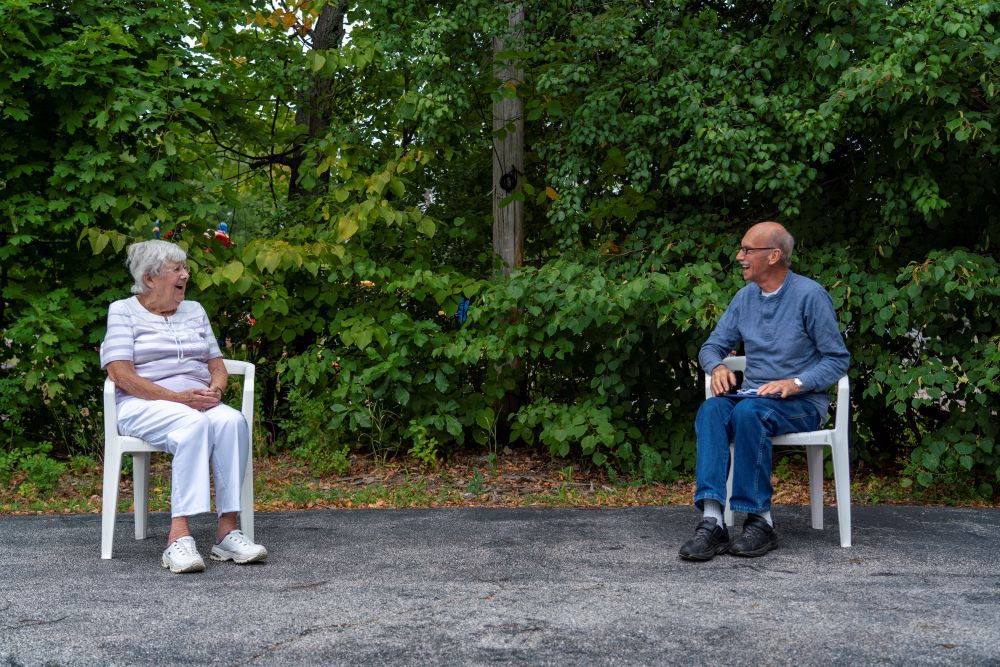Bridging the digital divide
 |
|
Connie Boutet and David Steed share a laugh. SUBMITTED PHOTO/Courtesy of Andrew Dickinson
|
A New Age Friendly Saco program will connect 25 participants with tablets and provide training to bridge the digital divide.
This new program builds on the handy-helpers initiative and is especially crucial due to older residents’ social isolation during the pandemic.
Connie Boutet is the first to admit she is not the most tech-savvy person.
But as COVID-19 has forced seniors like her into isolation, she saw an opportunity to learn new things that might help her stay connected.
“I know a gal who keeps her cell phone in the closet,” she said. “I want to join the party.”
A new Age Friendly Saco program will address the digital divide by offering eligible older residents the opportunity to purchase a subsidized tablet. Pairing with the organization’s Technology Handy-Helpers program, they will also provide full training to make sure participants get the most out of their new devices.
The mission of Age Friendly Saco is to promote active aging by optimizing opportunities for health, engagement, and safety while removing barriers that prevent our citizens from remaining in their homes as they age. Director Jean Saunders said COVID-19 has brought into full view the issues some of our older residents are experiencing in their inability to access the internet.
“In many communities, as has occurred in Saco, the only access that some of our older residents had was the local computer room at their local library,” Saunders said. “This room has been closed indefinitely due to the pandemic, and this program aims to find an alternate solution to provide that valuable resource for our community members.”
The pandemic has also changed the way many health care providers can see patients, namely by telehealth appointments.
“Many of our older residents do not have the training or resources to ‘get connected,’” Saunders said.
The Technology Handy-Helpers program consists of volunteers who are specially trained, and have experience, in helping residents’ access new types of technology that will allow them, at a relatively low cost, be safer in their homes and feel less socially isolated. They have installed “virtual personal assistant” devices, such as the Echo Dot, in some of Saco’s older resident’s households, helped with existing technology like cell phones or tablets, and installed smart home devices such as plugs to control lights.
David Steed, an Age Friendly Saco technology volunteer, answered the call when Connie initially needed help with her cell phone.
“We don’t know what they need until we get there,” he said. “We ask: What’s the problem, what do you need help with? But we keep all of it from being overwhelming.”
These volunteers help residents learn how to connect these devices and fully utilize all that these devices can do to help keep them safe. For example, they set up reminders when leaving the house such as “do you have your keys,” or, “is the stove turned off.” They also set up a tablet so that the individual’s contacts can be accessed during emergency as well as reminders for medications and appointments.
Boutet and Steed have installed a smart plug, and Steed helped Boutet set up and understand her tablet and cell phone. Recently, Boutet and Steed installed an Echo Dot. Now she asks Alexa to play some music, usually Lawrence Welk, and she’s learning new functionality by the week.
“I’ve been asking Alexa for phone numbers lately,” Steed said, “and I’m going to ask about spelling, too.” The new tablet program will follow the same income guidelines currently in place by the City of Saco to determine property tax relief eligibility to low income seniors. Each tablet will come equipped with standard applications as well as a Google account.
Learn more about the guidelines by contacting Age Friendly Saco at 710-5029 or [email protected].
“Since the mission of Age Friendly Saco is to enable our community members to age in place, this program will allow them to stay home and still have access to the news, telehealth visits, and stay connected with family and friends,” said Saunders. “Social isolation has been and will continue to be an issue with this age demographic as this high-risk population is encouraged to continue to practice social isolation for prolonged periods.”
Beyond the technology, this program is ultimately about increasing connection while remaining physically distant to keep everyone healthy.
When Boutet reflected on what it was like to meet with David for the first time and make the decision to learn new things, she said it wasn’t so hard.
“I just thought of him as a friend, and now I have a friend,” she said. Steed smiled and agreed.

